- Introduction
We are facing with various statistics about the seriousness of adverse contribution of construction sector to the environment, CO2 emissions, and depletion of energy sources. It is known that building construction uses %40 of natural sources, %12 of drinkable water, and %70 of electricity and also causes between %45-%65 of tailing (Yudelson, 2008). Therefore, the designers increasingly obey ecological designing principals for the purpose of creating a structured environment more compatible with the natural environment. Concordantly, the manufacturing materials are evaluated by continuously being improved and re-designed to be more sustainable. The textile material, one of these materials, is playing an important role in sustainable architecture, and is potently used in architecture with its features of manufacturing and transportation facileness, need of less supplies, and less energy source.
Textile based materials are used in architecture with their potential to decrease artificial energy requests, to alleviate cooling loads, and solar energy gain. With this usage in architecture, obtaining low energy costs in buildings is provided. For example membranes, which are a textile product are designed as to be easily disassembled and assembled via their flexible structure, are reducing waste amount by recycling after construction. Textile based materials also became prominent with aesthetic contributions to modern architecture along with their countless efficacies at saving natural sources and transferring them to posterities. These materials which are work of advancing technology provide an easiness to convert the structure to an intended form, inspire to exciting new forms with their texture, color, and shape, and add brand value to the structure.
2. Improvement of Textile Use from Past to Present
Textile material has emerged since the existence of human being by the need of protection against heat, cold, and climatic weather conditions. Traditional textile materials used for dressing and protection at the beginning have started to be used for aesthetic and visual quality purposes in the following periods. Developing technology by the invention of synthetic fiber has emerged a different type of textile. Technical and functional features have taken precedence over aesthetic and decorative features. This category has been accepted as a follow up of traditional textile industry as a separate field of industry and started to be used in architecture (Arslan, 2009).
3. Use of Textile in Architecture at Structure and Skin System
3.1 Material Characteristics of Textile Used in Architecture
There two basic materials used in skin system. They are classified as coated and uncoated. Uncoated ones have thin fiber and woven into the raw material at the places where coating will be applied. Coated materials; glass fiber coated PTFE (Polytetrafluoroethylene), polyester coated PVC (Polyvinyl Chloride), and ETFE (Ethylene Tetra Fluoro Ethylene) are the most widely used ones among the membrane materials. Coated materials make %90 of all membrane materials used in modern architectural projects (Drew, 2008).
3.1.1 PVC (Polyvinyl Chloride) coated polyester
PVC (Polyvinyl Chloride) and its derivations PVDF (Polyvinylidene fluoride), Teflon coated Fiberglass and silicon coated fiberglass are located in among the types of membranes that measured up themselves by their price and performance, and mostly used in construction sector (Pecina, 2012). Working life of PVC coating material is more than 25 years. Coating material is durable and have self-cleaning features. It is cheap and can be find in different colors. Polyester materials coated with PVC and PVDF are the most common waterproof materials. They can be used as weather protection at outdoor areas. Providing a good light transmission, they allow diffused natural light to fill the area to eliminate the need of artificial lighting. They have a good resistance and have a transparency between zero to twenty-five percent (Krüger, 2009). These types of textiles are successfully used for residual-permanent structures with its elastic cracking resistance. Coated textiles practically never necessitate any maintenance. By virtue of being recyclable, they also ensure to reduce the environmental damages. PVC coated polyester textile materials are very sufficient for demounted (removable and attachable again) structures with their foldable, movable, and storable features (Drew, 2008).
3.1.2 PTFE (Polytetrafluoroethylene) coated fiberglass
Glass fiber coated PTFE which is accepted as one of the membrane materials with its durability feature is the most recommended material for residual projects. It is expensive comparing to others. The material that has a good light transmission provides perfect long term protection and resistance against pollution with mechanical resistance of glass fibers (Beccarelli, 2015). At extreme climate conditions, it is a long term building material convenient to buildings necessitating long span. It is less affected from environmental conditions and ultraviolet lights. With its fire-resistance feature and over 30 years proved working life, PTFE membrane material has a good durability. It’s not molded and paled under the atmospheric impacts. It doesn’t hold rain water on it via its self-cleaning features. Because of its rain impermeability feature, it can be used as a weather protection for long spans and big scale modules. It is a textile material that has been advantageous with its textile material protection, resistance against chemicals, super incombustibility, ultraviolet light resistance and light reflection features. It has a very high UV resistance (Krüger, 2009).
3.1.3 ETFE (Ethylene Tetra Fluoro Ethylene) coated foil
It is the most used coating material of today (Beccarelli, 2015). ETFE is a material that has high translucency, economic, easily applicable, and has the best features at high scale projects. ETFE based membranes can be used in two different ways such as single layer or ETFE foil pillows. Single layer ETFE provides low insulation, but light transmittance is (%95) more. They can be manufactured at any form and size. Adding ETFE foils to the material, light transmittance and solar heat can be controlled. Multi-layer ETFE pillows can also be manufactured. Pillows are flexible with their geometric structure, and provides financial and energy conservation with their light-weight.
Not requiring advanced steel frames while applying ETFE material with its lightness and very similar glass look on long spans contributes to being frequently preferred at new buildings (Drew, 2008). ETFE material has mechanic feature and a good incombustibility (Beccarelli, 2015). It is a preferred material with its self-extinguishing feature. This type of textile material can be designed to provide compatibility and control against bright solar light, and patterns can be printed on to reduce the brightness. With its over 30 years working life, ETFE isn’t affected from environmental weather conditions and pollution. Isn’t paled or becomes embrittled in time, in turn, it shows that it is a long-lasting building material. Despite PVC and PVDF are a bit low-priced than ETFE and known better, ETFE is increasingly more demanded in construction sector because of the features it has (Krüger, 2009).
As the best known examples of ETFE material used buildings, Alliance Arena Football Stadium in Munich, Water Cube Olympic Swimming Pool in Beijing, and Eden Project in Cornwall can be counted (Drew, 2008).
3.2 Utilization Types of Textile in Architecture
Having various features and application potentials, textile is an important sustainable building material in architecture, especially for building shell. Textile materials are used for protection against weather conditions, optical protection, and privacy purposes throughout the history. When people adopted a sedentary life in time and started to construct more durable buildings, their utilization purposes became varied. Miscellaneous applications built in past have inspired the new, contemporary utilizations. Utilization areas of architectural textile on building and shell are given below (Table 1).
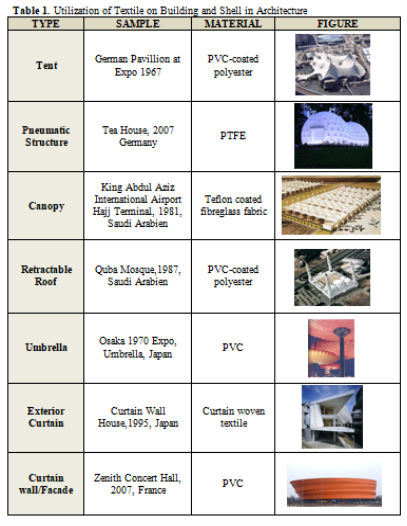
4. Visual Interactions between Textile and Architecture
There is visual Interaction between textile and architecture by means of production and aesthetics, and they also share their technology and information. These two disciplines have inspired each other in terms of visuality and form throughout the history.
4.1 At Buildings and Forms
While effecting today’s architecture on thought and shape by its utilization way, the textile which has been used as shelter cover since the primeval era also enabled obtaining extraordinary forms in architecture via performance features that were added to it. By the utilization of textile in architecture, it is benefited from the ability of material to create any type of free from. This provides a flexibility level that can be adapted to sculpture form or works of art (Heybroek, 2013).
An example to this is the work of sculpture of Indian origin English artist Anish Kapoor named “Marsyas” at Tate Modern Turbine in 2002. It was made by stretching PVC coated polyester textile membrane to three steel rings forming the frame like a skin (Garbe, 2008).
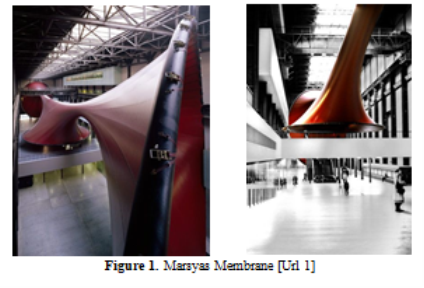
4.2 At Technology
By the development of fiber and emerging of smart textile and technical textiles, the textile material have been started to be used in architecture. Glass, ceramic, aramid, carbon fiber, liquid crystal polymer and polyethylene, along with PVC, PTFE and ETFE are being used in composite buildings, thus, they are enhancing the quality and performance of the building. Via textile, it is becoming possible to obtain forms that cannot be possible with traditional materials. The features such as shape, color and odor of smart textiles are being able to vary according to the heat, and the textile that has function of screening on building façade is becoming deflectable according to the angle of sun, to hour, and to weather condition. Printing applications are easily done on high performance smart textiles (Figure 2) (Tani, 2015).
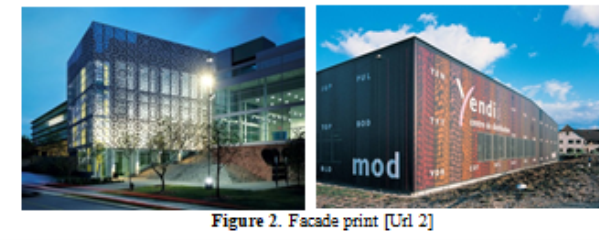
4.3 Aesthetic
Textile and architecture are two disciplines that have inspired each other throughout the history. There are marks of architectural era and buildings at fashion parades done by fashioners such as Gianfranco Ferre, Paco Rabanne and Huseyin Caglayan who had architectural education. While the fashioners are preparing their creations, from time to time they adapt from eras such as baroque, gothic on their pattern and forms. Similarly, architects such as Zaha Hadid, Frank Gehry have profited by the curled forms of textile on their buildings.
Draping or wrapping the architectural buildings with textile material the buildings were brought motion and aesthetic, and sometimes to get a message across to the public was provided. Reichstag German Parliament building was built in 1894, and has been the symbol of German democracy. By the works of artists Christ and Jean-Claude, 100.000 sq. woven polypropylene thick textiles have been dressed to the parliament building. The fabric which was specially woven for this project and exhibited for 14 days was two times more than the building surface. The curled structure of the fabric was used to emphasis the building, to make it magnificent (Figure 3) (Heybroek, 2013).
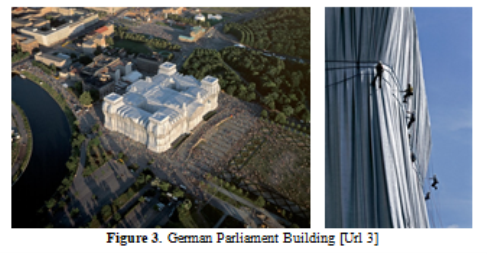
5. Sustainability in Architectural Textile
As a concept, sustainability is a phenomenon which doesn’t consume itself and its environment while producing something, and which protects posterities’ right to live and their habitat. This concept that gained importance after the world was threatened by problems such as environmental pollution, global warming, deterioration of ecological balance, and waning of water and energy sources, is important for all sectors. Main concerns of the textile used in architecture are:
- Recycling,
- Energy conservation,
- Necessary heat isolation
- Control of solar radiation (of gaining solar heat)
- Control of light transmission into indoor areas
- The best comfort conditions for the users in indoor life spaces,
- Resistance to self-weight, static snow load and dynamic loads (wind, earthquake, shock)
- Resistance to fire,
- Impermeability when wind and rain water are effective together,
- Control of vapor diffusion and vaporization occurrences,
- Noise insulation value,
- Ease of textile mounting and installation,
- Ease of cleaning and maintenance, (Motro, 2013).
6. On Textile Architecture Application Samples
The use of ETFE foil textile material on building shell of Eden Project in England, Water Cube in China and Alliance Arena Stadium in Germany has provided awareness in the world on both visual aspect and in sustainability issues.
6.1 Eden Project
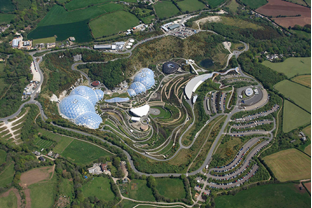
Figure 4. Eden Project [Url 4]
Eden Project is a textile building which was built in Cornwall province of England in 2001 that features the largest greenhouse of the world. The purpose of Eden Project is to teach the vital relation among the flora, people and sources, and to direct them to a sustainable life by encouraging individuals to this. The “textile shell building” made with ETFE material aiming to draw attention to the copula between human and plant ecology, is placed like a chain of soap bubble on to the land 8 crossing domes having 18 to 65 meter radii (La Cuyer, 2008).
Material’s high level elasticity has provided the most excellent realization of extraordinary shape of greenhouses and perfect heat isolation. Holding the air between two layers of ETFE, Hexagonal pillows on the top of steel construction in biome to keep the plants warm features a good isolation material. When Eden building was designed, it was thought that double-glassed domes as structural elements wouldn’t be that much sufficient to fulfill the need to have the highest transparency, thus, ETFE foil which is 100 times lighter than glass is used and the transparency of this material made gathering more light and heat possible (Heybroek, 2013).
The improved isolation features of ETFE significantly reduce the necessary energy to heat two biomes. This recyclable material also helps to keep indoor hotter in winter and cooler in summer (Drew, 2008).
6.2 Beijing National Aquatics Center (Water Cube)
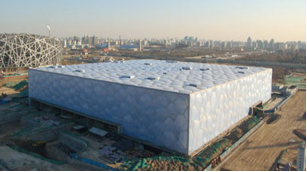
Water Cube building built in Beijing in 2003 is another important example to new generation buildings that have used ETFE air pillow systems just like it was in Eden Project to raise the efficiency to the highest level. Despite its brittle in appearance, it is ideally rationalized to seismic conditions at Water Cube building in Beijing, and it is seismically the most resistant building in the world (Le Cuyer, 2008).
To wrap inside and outside of the building, four thousand ETFE cells were needed (total of 100,000 sq.). ETFE has special features such as semitransparency, high radiation absorption and low UV absorption. Foil provides more light go inside and is a better isolation substance than glass. Coefficient friction of the material prevents dust collection process, cleans itself at every rain, and is more resistant against corrosion effect of solar light. Since airbags also function as sound absorber, this feature provides a significant benefit in terms of the noise created by the pools inside (Gonchar, 2010).
Semitransparent and recyclable ETFE panels provide visual comfort and visual connection with good illumination of the center via sufficient light level throughout the day. Passively heating the building and pool water, and converting the building to a magnificent glasshouse, double shell provides up to %30 saving comparing to high heating costs of indoor water sports centers. Water Cube holds %20 of the solar energy the building receives, consequently, reduces energy consumption at the rate of %30. The coating, with successive savings up to %55 at energy usage, also provides a good illumination of indoor during the day (Le Cuver, 2008). Double layer façade has three different climatic operating modes. During temperate mid-season, the air is let inside by opening the vents in skin. Fresh external air enters in through the outer skin, preheated by the sun in the cavity between skins, and then fills into the pool areas. During summer, when there are hot and humid conditions outside, internal air vent kept closed. Air cooled by passing over water around the building’s perimeter enters the cavity through a 1 meter high bank of vents, heats up, rises and is exhausted by roof vents. In winter, both skins are closed to achieve zero heat loss through infiltration, to maximize thermal performance. To reduce daily and seasonal temperature alterations, the heat flow of the pool water and the concrete pool and building structures are utilized to absorb the sun’s heat during the day and radiate it at night. By virtue of its permeability, the building is substantially illuminated by natural light, and illuminating cost is reduced in half (Moolman, 2007).
6.3 Allianz Arena
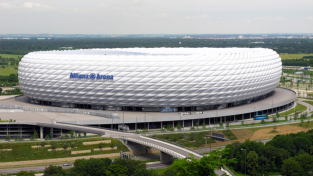
Figure 6. Allianz Arena Stadium [Url 6]
Allianz Arena that its construction was completed in Munich in 2005 is the largest football stadium having the biggest textile (membrane) skin (İtkib, 2005). In the shell of the construction 2.874 diamond shaped pneumatic ETFE textile foil (pillow) are used. Both to protect the audience against possible external damages, and to make use of solar energy most efficiently, inflated ETFE pillow is used on roof and façade (Orhon, Altın, 2014).
There are light effects illuminating the entire building at Allianz Arena. ETFE foil is programmed to reflect the colors football teams which are using the stadium by illuminating with red, white and blue colors of home football teams (Bayern Munich and TSV 1860 Munich (Jeska, 2008).
To create the light show more than 4000 energy saving LED lamps are used. Digitally controlled LEDs provide %60 energy saving and 362 tons of CO2 savings comparing to traditional illuminating methods.
0.2 mm thick ETFE membrane with %93 light transparency used on roofs and façades make the solar light available for the lawn in the building. To provide shadowing for the audience, the pillows are either transparent, or printed according to the location of the area. The horizontal tents extensible when necessary provide additional support for solar protection (Le Cuyer, 2008). Partly retractable tent system is equipped both with reflection and noise absorption features to cope up with solar radiation. ETFE membrane is fire resistant and has self-cleaning feature. Maintenance costs are less comparing to traditional construction forms (Flett, Schelbert, 2009).
7. Conclusion and Evaluation
In this paper, choosing architecture and textile that affect each other, the relation between these two separate fields. Today textiles that are produced with technical and performance features they have along with their aesthetic and decorative features have found an immense opportunity to use in architecture and construction sector.
The utilization types of textile made of enhanced materials are tent, pneumatic building, canopy, pleated roof, umbrella, parasol, outer curtain and shear wall/façade. With the utilization of textile in architecture it has been possible to give any type of free form to the building, an identity has been brought to the buildings by the help of technology, different appearance from other buildings have been provided to them. Aesthetically the textile makes the building one of a kind by rendering it attractive.
Three samples concerning utilization of textile based material on shell design in architecture are studied in the paper. These are Eden Project in Cornwall/England, Water Cube in Beijing/China, and Alliance Arena Football Stadium in Munich/Germany. The forms that are unrealizable with traditional materials have been implemented easily with these ETFE textile materials used on shells, roofs and lateral walls of these buildings. They have many favorable feature such as being recyclable, having very good insulation feature, reducing energy need by making use of optimum solar energy, fire resistance, self-cleaning feature, necessitating less maintenance cost comparing to traditional buildings. Unique worldwide samples composed by textile materials intensively used with these aspects attract millions of tourists by carrying brand value, and become the symbol of the city they situated.
Acknowledgement
This research did not receive any specific grant from funding agencies in the public, commercial, or not-for-profit sectors.
References
Arslan, K. (2009). Teknik Tekstiller-Genel ve Güncel Bilgiler [Technical Textiles-General and Current Information]-MUSİAD Araştırma Raporları: 58, Mart 2009, İstanbul.
Drew, P. (2008). New Tent Architecture, Thames & Hudson Yayını, Londra. https://www.bookdepository.com/New-Tent-Architecture-Philip-Drew/9780500342435
Flett, I., Schelbert, C. (2009). Herzog & De Meuron 1997-2001, Birkhauser Yayınevi. https://www.amazon.com/Herzog-Meuron-1997-2001-Gerhard-Mack/dp/3764386401
Garbe, T. (2008). Tents, Sails, and Shelter: Innovations in Textile Architecture. The University of Texas at Austin School of Architecture. https://soa.utexas.edu/sites/default/disk/technologies/technologies/09_03_fa_cremers_garbe_ml.pdf
Gonchar, J. (2010). Inside Beijing's Big Box of Blue Bubbles. McGraw-Hill Construction – Continuing Education Center, Architectural Record Yayınevi. http://www.epab.bme.hu/oktatas/2014-2015-2/v-CA-B-MS/FreeForm/Examples/WaterCube.pdf
Heybroek, V. (2013). Textile in Architecture. Master Architecture - Graduation Explore Lab Bouwkunde - TU Delft university of technology. https://repository.tudelft.nl/islandora/object/uuid:ffc472a7-b27a-4405-b623-b4433577e619/datastream/OBJ/download
Itkib Genel Sekreterliği Ar&Ge ve Mevzuat Şubesi. (2005). Teknik Tekstiller Üzerine Genel ve Güncel Bilgiler [General Information About Technical Textiles] . https://docplayer.biz.tr/7584429-Itkib-genel-sekreterligi-ar-ge-ve-mevzuat-subesi.html
Jeska, S. (2008). Transparent Plastıcs Desıgn and Technology. Birkhauser Yayınevi, Almanya. https://www.abebooks.co.uk/book-search/title/transparent-plastics-design-technology/author/jeska-simone/
Kruger, S. (2009). Textile Archıtecture. Textıle Archıtektur, Jovis Yayım, Münih. https://www.amazon.com/Textile-Architecture-Sylvie-Kr%C3%BCger/dp/386859017X
Le Cuyer, A. (2008). ETFE Technology and Design. Birkhauser Yayınevi. http://ww.resource-media.org/etfe_technology_and_design.pdf
Moolman, S. (2007). A magic cube. Civil Engineering.
http://www.idc-online.com/technical_references/pdfs/civil_engineering/A_magic_cube.pdf
Motro, R. (2013). Flexible Composite Materials in Architecture. Construction and Interiors, Birkhauser Yayınevi. https://www.amazon.com/Composite-Materials-Architecture-Construction-Interiors/dp/3764389729
Orhon, A., V., Altın, M. (2014). Spor Yapılarında Sürdürülebilir Çatı ve Cepheler. [Sustainable Roof and Facades in Sports Buildings] 7. Ulusal Çatı & Cephe Sempozyumu 3– 4 Nisan 2014 Yıldız Teknik Üniversitesi Beşiktaş – İstanbul. https://www.researchgate.net/publication/309673928_Spor_Yapilarinda_Surdurulebilir_Cati_ve_Cepheler/download
Pecina, P. (2012). Application of Tensile Membrane Structures in Architecture. Bachelor of Architectural Technology and Construction Management, University College, Denmark. https://issuu.com/p.pecina/docs/application_of_tensile_membrane_structures_in_arch
Tani, N. (2015). Enhancing the Spatial Experience Interweaving Textile, Human and Architecture. Master's Thesis Textile Art and Design Department of Design Aalto University, School of Arts, Design and Architecture. https://aaltodoc.aalto.fi/handle/123456789/16608
Yudelson, J. (2008). The Green Building Revolution. https://www.researchgate.net/publication/43296722_The_Green_Building_Revolution
URL 1: Marsyas (2017). http://www.balmondstudio.com/work/marsyas.php .
URL 2:Textile Facade Gallery (2017). http://www.fabricarchitect.com/textile-facades.html
URL 3: Wrapped Reichstag (2017). http://christojeanneclaude.net/projects/wrapped-reichstag
URL 4: Eden from the sky (2017). http://www.bbc.co.uk/cornwall/photos/eden/1.shtml
URL 5: The Water Cube, Bubble-Clad Olympic Wonder (2017). http://www.cawater-info.net/all_about_water/en/?p=3321
URL 6: Las 13 ciudades donde se jugará la proxima Eurocopa (2017). https://www.infobae.com/playfutbol/fotos-al-100/2016/07/13/las-13-ciudades-donde-se-jugara-la-proxima-eurocopa/
How to Cite
ALIOGLU, T., & SIREL, A. (2018). The Use of Textile-Based Materials in Shell System Design in Architecture and an Evaluation in Terms of Sustainability. Journal of Contemporary Urban Affairs, 2(3), 88-94. https://doi.org/10.25034/ijcua.2018.4722
This work is licensed under a Creative Commons Attribution - NonCommercial - NoDerivs 4.0.
"CC-BY-NC-ND"